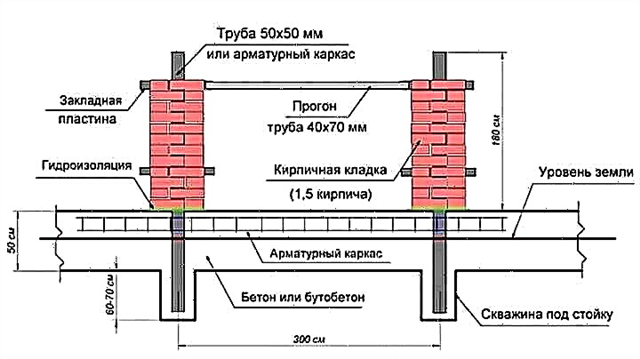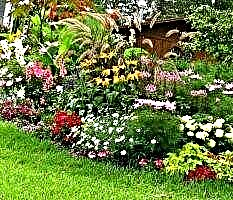
Protective compounds based on vegetable oils have been known to mankind since ancient times, and until the 20th century they remained one of the few ways to effectively protect wooden parts from rot and parasites. Before, various resins were often added to “boiled oil”, which improved the characteristics of the resulting mixtures and turned them into an analogue of modern varnishes. Nowadays, such a practice, as well as the independent preparation of protective compounds, is a thing of the past - after all buy cheap drying oil in Voronezh or any other large city is not difficult, besides the attention of customers everywhere offered a rich assortment of such coatings.
Both dear and the cheapest drying oils They have the same mechanism of action: these are substances that in a thin layer after drying in air form an elastic soft film that does not dissolve in organic solvents and water. Film formation occurs due to the polymerization of vegetable oils, the whole variety of which is divided into drying, semi-drying and non-drying. The first type includes flaxseed, hemp, nut and poppy seeds, the fatty acids of which contain double bonds; it is on their basis that they produce the highest quality compounds for treating wood and metal for future painting. Semi-drying - sunflower, soy, and a number of others - on the contrary, contain saturated acids, double bonds in which form only with time, as a result of chemical reactions. Such raw materials are also used in the paint and varnish industry, but only after preliminary processing. Finally, castor, olive, and rape are non-drying ones: linoleic acid is practically absent in them; therefore, the oxidation reaction of these compounds does not occur in air and a protective film is not formed.

Having decided buy drying oil, in most cases, the average person will be faced with a choice between oil, alkyd and composition, differing in characteristics and specifics of application. Moreover, all of them necessarily include, in addition to the base, also driers - salts of iron, manganese, cobalt, lithium, lead, zirconium or strontium, which accelerate the drying process due to the active absorption of atmospheric oxygen, distinguish between monometallic and polymetallic driers, the latter in several times accelerate drying. It should be noted that these additives continue their “work” even after the appearance of a protective coating, therefore their share in the solution is no more than 2-4% so that the resulting film does not lose strength and does not darken over time.
One of the most expensive options for protecting wood today is natural oil coatings manufactured in accordance with GOST 7931-56, linseed oil is considered the best raw material for their production, although in Russia sunflower, hemp and soy are also widely used. In such formulations, 97% is the basis, and the working solution has the form of a thick opaque liquid, the shade of which can vary from greenish to dark brown. As a rule, the client is faced with a choice: buy polymerized drying oil or oxidized. The first is obtained by heating the oil to + 275 ° C in the presence of polymetallic desiccants and "languishing" it until the required viscosity is reached. In the second case, the raw material is first heated to + 150-160 ° C and subjected to air purging for 4-4.5 hours, after which “languishing” begins in the presence of a desiccant, which in this case requires significantly less. Both versions of the compositions have a very light sweetish smell used as the basis of raw materials, give good hiding power and dry completely within 24 hours, without tack, which makes them ideal for work in any premises, including children's rooms, kitchens and bedrooms.

For those who are looking for the best value for money, suitable cheap drying oil "Oksol" wood and metal. As in oxidized formulations, the raw materials for its production are first heated to + 160 ° C and blown with air, and then solvent and desiccant are introduced into it, the finished mixture has about 55% of the base, 42% of the solvent - in most cases of white spirit - and 2-3% of desiccant. When cooking the most inexpensive options, sometimes heating is not even used, all the necessary components are simply mixed with each other in the right proportion. You can usually buy in Voronezh "Oksol" in containers of 0.5 l, 1 l, 3 l, 5 l and 10 l, the main field of application of these coatings is the coating of wooden, metal or plastered surfaces for painting with oil paints, or for diluting the latter to the desired consistency. Compared to natural coatings, inexpensive "Oksol" differs by faster drying and increased hardness of the glossy coating formed on the surface. The mixture penetrates perfectly into the pores of the tree, emphasizing the structure of the material, and at the same time provides an excellent substrate for subsequent coloring or varnishing. Its only drawback is the presence of a pungent odor that gives white spirit, so all work should be carried out in well-ventilated areas.
Necessity buy alkyd drying oils, as well as compositional ones, it occurs much less often for the average person, since they have a narrow “specialization” in application. The first, divided into glyphthalic, xyphthalic and pentaphthalic, are widely used in the manufacture of oil paints and are modified solutions of alkyd resins in white spirit, with the addition of desiccants. For composite mixtures, it’s not at all vegetable oils that are used, but their synthetic analogues - products of oil refining, coal, rubber waste, fuses (vegetable oil sludge), osprey (petroleum resin). The resulting mixtures are used in industry and for processing various production facilities, it is categorically not recommended to use them in everyday life, despite the extremely low cost - all the more so since surfaces coated with such a mixture often do not dry out and cannot be painted.
Having opted for buy a good drying oil for processing wood, metal or plaster, to acquire a quality product, it will be enough to adhere to a few simple rules. Firstly, the lower the transparency of the solution, the better - only composite mixtures have high transparency, while natural plant materials always give dark, saturated tones and low transparency to ready-made mixtures. Naturally, in such paintwork materials there should be no extraneous inclusions, suspensions and sediment. Secondly, it is better to give preference to trusted manufacturers, since such companies value their reputation and more strictly monitor compliance with GOST and TU when releasing their products. For example, they are popular with customers. drying oils "Rainbow". Thirdly, the surface for drying should be cleaned of old paints and varnishes, and if necessary, additionally degreased. Finally, if further painting or varnishing is planned, coatings should be selected that will optimally combine with the coating of the substrate.
Appointment and application of drying oil Oksol
The product is a viscous liquid product, which consists of several components. The task of the product is the surface treatment of wood material, the preparation of the plastered surface, and is also used as a solvent for diluting oil paints.
Dryse Oxol is a very toxic and flammable product, therefore, it requires the observance of certain safety measures.
- Staining should be performed only in special clothing that reliably protects the skin of the hands from the product.
- When working, it is necessary to use a respirator to protect the human respiratory system.
Important! If the product nevertheless gets on the skin, it is urgent to remove it with vegetable oil (a dampened cloth or rag). Then the place is washed with soapy water and finally washed with running water.
Before applying, the place for the proposed painting should be cleaned of all kinds of contaminants and greasy stains, then sanded and wiped the surface. If the product has not yet been used, then it must be thoroughly mixed. In the case of repeated use, drying oil can thicken, then it needs to be diluted with a little solvent. The tool is evenly applied to the treated area using a roller or brush with a thin layer. The next one can be applied only after the previous layer has completely dried.
Oxol is not used for painting floors and surfaces that are exposed many times during the day. This product has gained wide popularity in the building materials market due to its excellent properties and high efficiency. Famous domestic enterprises are engaged in the production of linseed oil Oksol: Khimtek Production Association (Yaroslavl), Vesta Color LLC (Kazan), Tex company (St. Petersburg). The products meet the requirements of GOST 190-78 "Olif Oxol. Technical conditions ”, has an affordable price and high quality indicators.
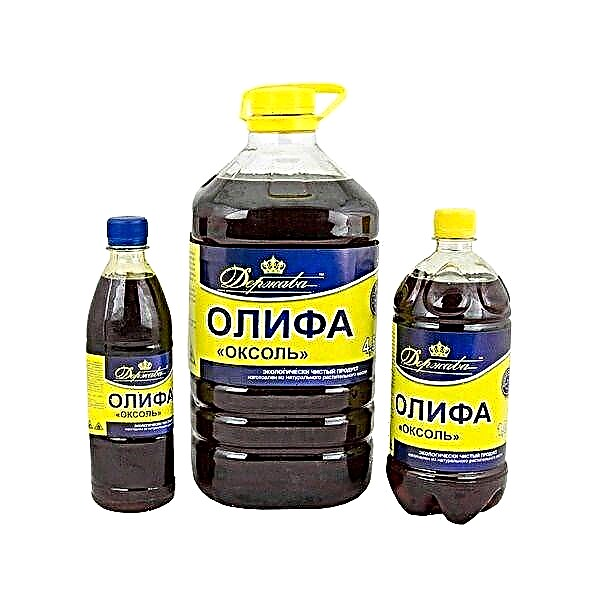
Grades drying oils Oksol
On sale there are two brands of funds that differ from each other by the name of the main component and its percentage ratio:
- “B” - the basis of the product is linseed or hemp natural oil. Linseed oil based linseed oil is considered the most suitable for outdoor use, since it creates a more dense protection and provides millet coating,
- "PV" - the rest of the natural oils are used in the product (soybean, sunflower, corn, grape). Such drying oil is less resistant to external influences.
Both product brands are not inferior in technical characteristics to other types of drying oils (natural, combined, alkyd). The surface is obtained with a spectacular gloss, waterproof. It freezes, of course, only after a day, but has good durability.
Composition and specifications
The production of linseed oil Oksol is carried out in accordance with state standards and norms, depending on the brand of the product. The remedy consists of 50 to 55 percent of herbal oils. It can be sunflower, flax, grapes, hemp, corn, soy. The rest is a solvent (white spirit - 40%) and desiccants, which together provide the drying oil with the necessary concentration and improve the degree of drying of the product.
When used, Oxol forms a film on the surface that prevents the penetration of the paintwork deep into the material. Oil significantly improves the adhesion (adhesion) of the paint or varnish to the wood material.
Key indicators characterizing the product:
- Colour. This factor is unchanged for both brands and should exceed 800 mg j cc. An exception is made up of linseed oil based on camelina and soybean oil (1800 and 1100 mg, respectively).
- Viscosity. It is determined by the device with a viscometer and practically does not differ in magnitude for the two options B and MF.
- Acid number. For brand B, it should not be more than 6, for another brand - 8. In case of using the product in sunflower oil, the value varies from 8 to 15.
- Mass fraction of non-volatiles. In both cases, the indicator is in the range of 54.5 - 59 percent depending on GOST.
- Sludge in volume. Should be the same - 1 percent.
- Transparency. Both options are available with full transparency.
- Drying time. Grade B completely hardens after 20 hours from the moment of application, and PV only after 24 hours. Such a difference depends on the composition, manufacturing technology and the number of additional elements in the varnish.
- Flash point should not be more than 32 degrees Celsius.
Consumption per 1 m2
Drying oil, like all other oil paints, has about the same consumption per square meter of the treated area and is equal to 80 - 130 grams. The amount of drying oil used will depend on the type of wood, its porosity, hardness and moisture. For example, when processing still fresh and raw wood, the consumption can reach 200 - 250 grams.
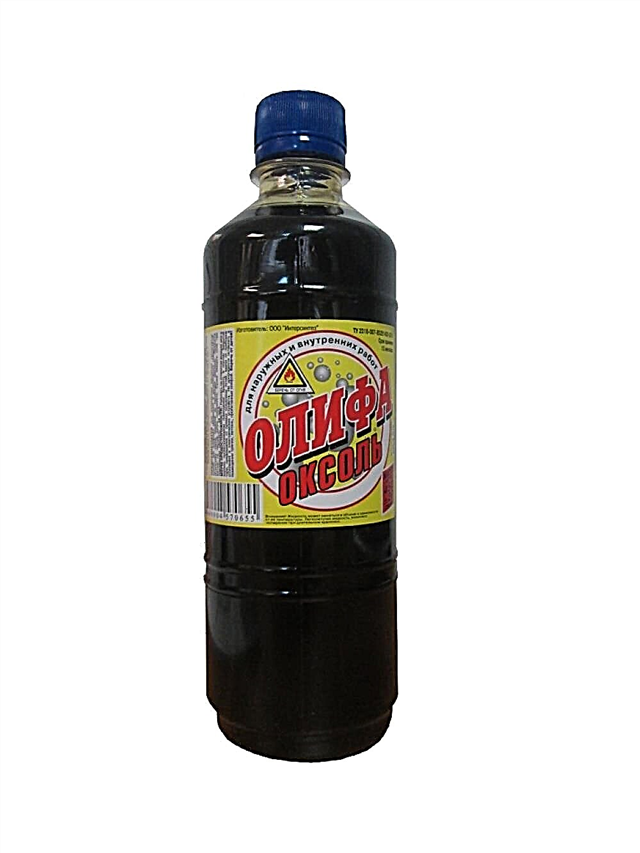
Advantages and disadvantages
Olifu Oxol can be used not only for wood material, it is perfect for other objects. This is due to its technical characteristics. There are a number of other advantages over other types of drying oil:
- provides the material with a shiny and hard protective layer,
- high degree of water resistance,
- behaves well in adverse weather conditions,
- perfectly absorbed into any surface of a tree with varying degrees of porosity,
- increases the operational characteristics of wooden structures,
- not destroyed by sudden fluctuations in ambient temperature,
- fungus and mold do not act on it,
- when applied, the product smoothes the surface,
- it is highly soluble in oil paint, which allows to increase the volume of paint material,
- can be used as an impregnation.
In addition to the advantages, drying oil has disadvantages:
- afraid of constant mechanical stress,
- has a sharp unpleasant odor, which is strongly eaten into the material and does not weather for a long time,
- flammable.
Application tips and tricks
- Before buying, you should carefully read what is written on the product packaging label, namely for what types of work it can be used (external or internal), which manufacturer and its coordinates
- No impurities should be contained inside the container.
- When using Oxol, do not allow open sources of fire. All electric lighting and electrical equipment are explosion-proof.
- The room in which it is supposed to work with drying oil should be well ventilated or equipped with forced-air and exhaust ventilation.
- Before opening, the container with the liquid must be thoroughly shaken.
- To apply a thinner layer, it is recommended to use a wide brush or roller.
- To protect the skin of the hands you need to use rubber gloves (household or medical).
Compliance with the basic rules for the treatment of drying oil allows you to get high-quality coating quite quickly and easily.
Drying time
This parameter directly depends on the brand of the chemical product, as well as the conditions (humidity and air temperature) inside the workroom. The drier the wooden structures, the faster the drying process of drying oil will proceed.
Tip. The coating should dry under natural conditions, it is not recommended to specifically create a higher temperature using special heating equipment. Otherwise, drying oil will quickly crack. Drafts should also be avoided.
Drying oil - features and application
Drying oil is an impregnating agent that is applied immediately before further painting. It is a thick, oily liquid, mostly brown. What is drying oil used for?
- It can be used to impregnate wooden structures inside and out. This allows you to save the tree, reduces the impact on it of various external, aggressive factors (including moisture). Such a protective layer protects the wood from insects and various fungi and bacteria.

Photo Olifs Oksol TEKS
- It is suitable for impregnation of external and internal plastered surfaces. In this case, drying oil allows you to slightly level the surface, and reduce the consumption of paint, which will be used after it.
- Dilution of oil-based paints. Such a simple method increases the amount of paint, allows you to rehabilitate even a thickened, old mixture. However, drying oil can only be mixed with oil-based paint, otherwise it will just ruin the product.
Oxide drying oil is produced in special plastic containers, metal barrels. The packaging always indicates all the necessary information (composition, manufacturer, important characteristics, sometimes - the nuances of use).
Types of drying oil Oksol

Dryse Oxol is a semi-natural remedy. 55% of it consists of vegetable oils. 40% is a solvent, the remaining 5% are desiccants (fused, fatty acid or oil resinates). Thanks to the desiccant, drying oil hardens and is actively absorbed into the wood. White spirit, pyrolene, C4 nephras, turpentine turpentine can serve as a solvent. The amount and type of additives is determined according to the standards of GOST 190 78.
There are two types of linseed oil Oksol.
- Dryse Oxol B - made from hemp or linseed oil. It is used to dilute ready-to-use oil paints, or for thick mixtures that are applied during exterior or interior use.

Photo drying oil Oksol PV
- Drying oil oxol PV - produced using safflower, sunflower, corn, camelina or grape oil. Less commonly, a combined mixture of any of these oils is used or substitutes are taken (light petroleum polymer resins). But, if synthetic analogues are taken, then their share should be up to 40%. This type is used only for internal work.
Technical characteristics of drying oil Oksol
The exact composition of drying oil Oksol, conditions, features of use and the like, is regulated by GOST 190 78.
| Name of indicator | Norm for stamps | |
| IN | PV | |
| 1. Color on the iodometric scale, mg J2 / 100 cm3, not darker | 800 | 800 |
| 2. Conditional viscosity with a viscometer of the type VZ-246 (or VZ-4) with a nozzle diameter of 4 mm at a temperature of (20.0 + - 0.5) ° C, s | 18 - 22 | 19 - 25 |
| 3. Acid number, mg KOH / g, not more than | 6 | 10 |
| 4. Mass fraction of non-volatiles,% | 54,5 - 55,5 | 54,5 - 55,5 |
| 5. Sludge in volume,%, no more | 1 | 1 |
| 6. Transparency | Full | |
| 7. Flash point in a closed crucible, ° С, not lower | 32 | 32 |
| 8. Drying time to degree 3, h, at a temperature of (20 + - 2) ° C, no more | 20 | 24 |
- Combustible mixture. The auto-ignition temperature depends on the type of additives and starts at +245 degrees.
- Flash point in a closed crucible +32 degrees.
- The smell is strong.
How to use drying oil Oksol
It is not difficult to use drying oil Oksol. The first step is to clean the surface to be soaked from dirt, grease, dust and old coatings. It is important that the surface is dry. It is best for drying oil at a temperature of + 15 ... + 20 degrees and humidity up to 75%. Regardless of whether the combined or simple mixture is taken for work, it can be used immediately after opening the can. But first, the mixture is mixed.
Apply it in a thin layer with a brush or roller. If it is necessary to make several layers, an interval of 24 hours is maintained between them. If after use the liquid remains in the jar, it can be stored for up to 12 months. But first, the jar is well corked. Ideally, the storage area should be dry, with low humidity and protected from fire, sunlight and any heat sources.
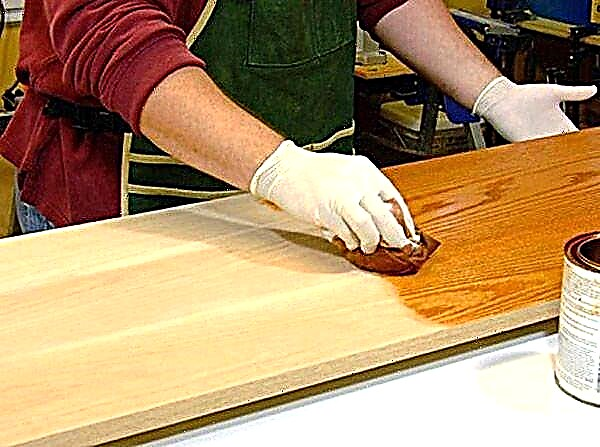
How to use drying oil Oksol
If you need to close the gap in the wood, you can mix the drying oil with sawdust in equal proportions and clog the resulting mass with a spatula. The mixture will not dry quickly, but after it hardens, the gap will be permanently eliminated.
Consumption of drying oil Oksol on 1 m²
Before applying Oksol drying oil, you need to know the consumption per 1 m². Depending on the type of substance, the flow rate may vary.
- When treating surfaces with grade B, a flow rate of 80-120 g / m² must be taken into account.
- When working with the PV category, the consumption per 1 m² is 100-150 g.
But these are only approximate values. The fact is that in different cases one or more layers of drying oil are applied to a tree or putty. Consumption is influenced by many factors. For example, old wood or plaster will require more drying oil for impregnation. And even the type of tool with which it is applied can affect the flow rate - it is less with a brush than with a roller. In addition, sometimes you need more money, sometimes less to dilute the paint.
Producers of linseed oil Oksol
A good drying oil is not sold everywhere and not under every brand. Only a few, reliable manufacturers can boast of high technical characteristics.
- «Isolate » - a manufacturer known for its quality. Produces drying oil Oksol by standards. It sells products in a volume of 0.5-200 liters. However, it is difficult to find in the market. Most often, the company's products are manufactured to order, in large batches.
- VESTA-COLOR - also a well-known manufacturer. The drying oil of this brand is high quality. It can be produced in large and small batches, in different volumes and on order. The price is reasonable, technical specifications are good.
- Tex - produces Oxol drying oil according to the standards specified in GOST 190 78. Raw materials are poured into cans weighing 0.4-8 kg. The composition dries quickly after application, reduces paint consumption, can be used as a primer.
- Khimtek makes drying oil of good quality. Products have an affordable cost, are available in different containers and in different volumes.
- The coachman for the most part it produces drying oil Oksol PV with a volume of 0.8-20 kg. The composition complies with GOST standards, available for sale at a low price.
Drying oil Oxol allows you to save wood from decay and bugs, improve the application of the finish coating on the putty or increase the amount of paint in the can. It is convenient and profitable to use and therefore appreciated by builders around the world. It is recommended to purchase it in specialized stores, paying attention to the manufacturer. After all, only good companies known for their reliability can provide a guarantee of quality.
Option number 1. Natural compounds
The natural group is almost entirely composed of natural oils. The production and composition is regulated by the Soviet GOST 7931-76, according to this standard, the real good impregnation should consist of 97% of natural oils and only 3% falls on the so-called desiccant.

Impregnation is most conveniently applied with a brush.
Oxides of manganese, iron, cobalt, etc. act as a desiccant. This additive is needed to enhance the film-forming effect, in other words, so that the impregnation dries. Without a desiccant, the impregnated surface will never dry, at the same time, if the dose is increased, the coating will become brittle and will crack over time.
In fact, drying oil can be cooked from any natural vegetable oil, but most often linseed, hemp, sunflower or tung oil is used for these purposes. Flax impregnation is considered to be the best, it dries in about a day, hemp goes behind it, and drying oils from sunflower and olive oil dry for the longest.

Natural compounds have the highest cost.
Although formally natural drying oils are classified as varnishes, in fact they are closer to the primer. These compounds can be considered universal, they can be used everywhere, but since the price is quite high, such drying oils are used only for impregnation of elite wood, restoration work and the production of expensive paints.



